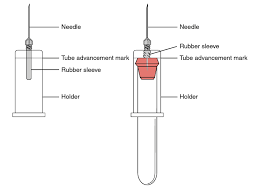Which of the following blood collection systems uses interchangeable multi-sample tubes that allow a phlebotomist to draw several blood specimens at the same time?
Evacuated tube system
Hypodermic needle and syringe system
Winged infusion set and syringe system
Lancet micro collection system
The Correct Answer is A
Choice A Reason:
The evacuated tube system is designed for the collection of multiple blood specimens using interchangeable tubes. This system utilizes a double-pointed needle, one end of which goes into the patient's vein and the other into a vacuum tube. As the blood is drawn, it automatically fills the tube until the vacuum is exhausted. The phlebotomist can then easily replace the filled tube with another without removing the needle from the patient's vein, allowing for multiple samples to be taken during a single venipuncture.
Choice B Reason:
The hypodermic needle and syringe system is typically used for manual blood draws when the evacuated tube system is not suitable, such as with small or fragile veins. This system does not use interchangeable tubes; instead, the blood is drawn into a syringe and then transferred into the appropriate tubes, which can be time-consuming and increase the risk of hemolysis or contamination.
Choice C Reason:
A winged infusion set, also known as a butterfly needle, is often used for patients with difficult veins. Like the hypodermic needle and syringe system, it does not inherently allow for the use of interchangeable multi-sample tubes. Blood is collected into a syringe or a single tube attached to the butterfly needle, and changing tubes usually requires a new puncture for each sample.
Choice D Reason:
The lancet microcollection system is used for capillary blood collection, typically from a fingerstick or heelstick. It is used for small volume samples and does not accommodate interchangeable multi-sample tubes. This method is commonly used for pediatric patients or when only a small amount of blood is needed.

Nursing Test Bank
Naxlex Comprehensive Predictor Exams
Related Questions
Correct Answer is D
Explanation
Choice A Reason:
Disposing of contaminated materials is a part of standard infection control practices. While it is important to dispose of materials that may be contaminated with blood or bodily fluids properly, this action is not specific to the aseptic technique used during venipuncture.
Choice B Reason:
Performing hand hygiene once daily is not sufficient for maintaining aseptic technique. Aseptic technique requires hand hygiene before and after each patient contact, especially before procedures like venipuncture to prevent the transmission of pathogens.
Choice C Reason:
Completing quality control procedures is an essential part of laboratory practice and patient safety but is not directly related to the aseptic technique of venipuncture. Quality control ensures the accuracy and reliability of test results rather than preventing infection.
Choice D Reason:
Cleansing the skin with sodium hypochlorite, or a similar disinfectant, is a critical step in aseptic technique for venipuncture. This action reduces the microbial load on the skin, thereby minimizing the risk of introducing pathogens into the bloodstream during needle insertion.
Correct Answer is D
Explanation
Choice A Reason:
A red-top tube is used for serum determinations in chemistry and should be allowed to clot completely, typically for 30 minutes, before centrifugation. Shipping after only 15 minutes may result in incomplete clotting and potentially inaccurate test results.
Choice B Reason:
Serum should not be separated from a lavender-top tube, as this type of tube contains EDTA and is used for whole blood tests, not serum. This indicates a misunderstanding of the tube's purpose and could lead to compromised test results.
Choice C Reason:
A tiger-top tube, also known as a serum separator tube, is used for various chemistry tests. However, bilirubin is light-sensitive, and specimens for bilirubin testing should be protected from light, not shipped in a clear bag. This could lead to degradation of the bilirubin and inaccurate results.
Choice D Reason:
A green-top tube contains heparin and is used for plasma determinations. Ammonia testing requires the plasma to be placed on ice immediately after collection to inhibit the continued production of ammonia from red blood cells. Therefore, shipping in an icy water mixture is the correct procedure to ensure accurate ammonia levels.
In conclusion, the proper preparation and transport of blood specimens are crucial for the accuracy of laboratory tests. The green-top tube for ammonia testing, shipped in an icy water mixture, is the only option that follows the correct protocol for specimen handling and transport.
Whether you are a student looking to ace your exams or a practicing nurse seeking to enhance your expertise , our nursing education contents will empower you with the confidence and competence to make a difference in the lives of patients and become a respected leader in the healthcare field.
Visit Naxlex, invest in your future and unlock endless possibilities with our unparalleled nursing education contents today
Report Wrong Answer on the Current Question
Do you disagree with the answer? If yes, what is your expected answer? Explain.
Kindly be descriptive with the issue you are facing.
